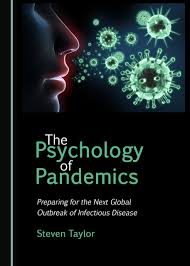“Pandemic influenza is one of the leading health threats currently facing the world” (opening of Chapter 1)
The Psychology of Pandemics was published before the current crisis in 2019 and provides a clear overview of the nature of pandemics and the human behaviours associated with them. It predicts much of what is happening around the world as I write this (on 27 April 2020).
Many people fear for their health, safety, family, finances, and jobs during such health crises, and understanding the psychology behind such reactions is important to mitigating their impact. Steven Taylor writes that there are three essential elements in a pandemic: an infectious agent, the environment, and people (hosts). Our resistance to infection depends on the strength of our immune system, but equally importantly on how we mentally cope with threatened and actual infection.
What is a pandemic?
People vary widely in how they react to such threats, and the author makes good use of historical data and testimonies to highlight key points, starting with the Bubonic Plague (1346-1353) which killed around 50 million people. The last century has seen many more pandemics, and Steven Taylor quotes other authors that, “with modern rapid transportation facilities, [any] epidemic would spread like wildfire, reaching every corner of the globe. Many millions of people would become ill and there would certainly be many deaths.”
He discusses the importance of superspreaders who contribute disproportionately to spreading infections, because they are often more susceptible to infection, have poor basic hygiene, come into contact with many people (because of their occupation or social behaviour). Superspreaders are particularly important when the infection has a long incubation period where no symptoms appear.
Managing pandemics
Steven Taylor details four main methods used to manage the spread of infection:
- Risk communication through public education
- Vaccines and anti-viral therapies
- Hygiene practices
- Social distancing
Clear communication is the core of establishing trust with the public, although the author argues that this is where governments and public health authorities are least prepared (arguably risk communication from those in charge has been much weaker than the public’s following of hygiene practices and social distancing in the present crisis).
The psychology of pandemics
Steven Taylor points out that the key methods for managing pandemics rely on education and behaviour change where psychology plays a big role. While most humans are resilient to stress, the evidence suggests that the psychological impact of Covid-19 will be larger than the medical impact. The number of people affected by the Ebola epidemic and SARS outbreak were overwhelmed by the “epidemic of fear” that was associated with them.
Reactions to pandemics “range from fear to indifference to fatalism”, and while many people disregard or deny the risks, others react with anxiety or fear. If anxiety or fear is moderate it helps us manage to cope, but when it becomes severe is debilitating. Regular handwashing is good, but microwaving bank notes (as one woman did during SARS) is dangerous (and also costly)!
Such outbreaks can also trigger mood and anxiety disorders and posttraumatic stress disorder (PTSD) as we become aware of our mortality. Some people who lose loved ones may also suffer from depression or severe grief. For example, different studies estimated that 44% of patients and 10% of hospital workers during SARS later developed PTSD.
The perception of danger and desperation for protection can also make people highly irrational, turning to quack cures and dubious remedies (remind you of anyone?). Historically, necklaces of garlic, consuming pine tar, and eating turnips, vinegar and kimchee have been misconceived prophylactics. A Canadian man drunk hydrogen peroxide to protect himself from the Spanish Flu and similar remedies have been touted this month.
How do different people react?
Neuroticism, or negative emotionality, is the trait most associated with anxiety and depression in response to stress and is a risk factor for many mood and anxiety disorders, for both the general public and healthcare workers. People with this trait are more likely to overestimate threats, feel more anxiety, and have obsessive-compulsive disorders.
There are broadly two types of people in the way that they seek and process information about potential health threats. Some people seek information (“monitoring”) and others avoid information (“blunting”) and these coping strategies are commonly used to understand different behaviours and target messages.
When we are threatened by disease, our behavioural immune system (BIS) kicks in, and emotional motivators such as disgust and fear become more vigilant. Bacteria and viruses are too small for us to see, so we focus on those cues that we can sense, including noxious smells and visual cues (e.g., people coughing or sneezing). Our BIS is biased towards ‘false positives’ to minimize the chances of missing a potential threat and is especially sensitive when we feel vulnerable. This system heightens negative reactions to “out-groups” who are perceived to me more threatening.
How best to communicate risks?
Do logical or emotional appeals work best? While facts and statistics are important (and in the present crisis sobering), emotional appeals and individual stories are often more vivid, concrete, and image-evoking.
However, while frightening people is a common tactic in health promotion campaigns, often the combination of this with more reassuring messages can work better. Educating people about how to better protect themselves can also give them a greater sense of control over their own future (i.e., a sense of agency). “Monitoring” strategies are more sensitive to emotional (fear-evoking) messages, while “blunting” strategies may be more receptive to logical (fact-based) messages, so consider a combination of both.
Our perceptions of risk depend on our perception of psychological distance:
- Spatial distance – how close or far is the disease?
- Temporal distance – how immediate is the threat and is it new?
- Social distance – are your immediate family and friends at risk?
- Probability distance – what is the chance of encountering the disease? This is where the “availability heuristic” comes into play.
Be better prepared
Steven Taylor concludes by arguing that the next pandemic (i.e., the current one) is likely to be “complicated, unpredictable, and turbulent”. Apart from the importance of vaccinations, he highlights two specific areas where government and health organisations need to be better prepared: improved risk communication and addressing mental health issues.
My own observation is that in the current crisis, government agencies have performed worse and the general public have performed better than Steven Taylor anticipates. However, I do wish I had read this book at the end of last year, when it was published, and can recommend to anyone who wants to better understand Covid-19 and the reactions of other people, and themselves, to this tragedy.






